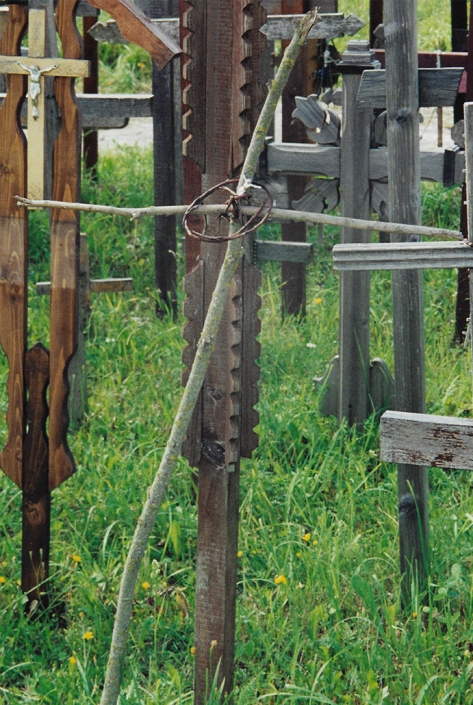Lithuania and the extraordinary Hill of Crosses
LITHUANIA may still be seen as the poor cousin of its Baltic neighbours. But things are finally starting to open up, albeit slowly.
These are people who don’t like to let go of the past. The last country in Europe to accept Christianity, religion evolved to embrace a Catholicism which sprang intriguingly from a deeply pagan root system.
The resultant pick ‘n’ mix imagery – particularly at big outdoor festivals and sacred sites – is a wonder to behold.
Since Latvians next door gained their independence in 1990 and Estonia celebrated its freedom, it seems as if Lithuania in the same timescale, is only just beginning to haul its way into the 21st century.
There are stirrings, though and where the streets of Tallin are well-trodden by visitors, particularly from Scandinavia and especially Finland, and Riga has collected enthusiastic reviews, in Vilnius too there’s a welcome, even if it still feels more like virgin territory.
So this is a fascinating destination, and one to hurry up and see before it starts to clone itself with the rest.
The difference was glaring as soon as we hit the border post and prepared to leave Latvia. Old-style farming is still very much the backbone of the country. Working horses haul ancient wooden carts along roads so straight that if you try to focus on the point where they tail off on the horizon, it makes you cross-eyed. Machinery of the vintage normally found in collectors’ sales elsewhere, is still in daily use.
Nowhere in the country – or any other country for that matter – will you find a more striking symbol of that Christianity v. Paganism mix than at the extraordinary Hill of Crosses outside the city of Siauliai.
Sacred place
The great mound, a sacred place unlike any other, attracts solemn pilgrims as well as curious non-believers who pick their way through its claustrophobic corners in their hordes.
Its early form first sprang up in the mid 19th Century when local peasants and craftsmen mounted a revolt against oppression and the ringleaders were massacred.
Grieving families decided to erect a memorial cross on the highest mound and in the years that followed, more were added to commemorate the passing of other distinguished citizens.
By the start of the 20th Century, people were already travelling here from all over the country, believing in a powerful force of healing or that, at least, they’d be protected against misfortune.
When the country again fell under the grip of the Soviets, the authorities ordered its destruction. The hill was bulldozed flat and deep ditches were excavated and filled with water to block all access to the site. The KGB even ordered the construction of a police station next to the hill and planted poplars and lime trees to cover the mound.
But, the unstoppable desire to go to the Hill and to share its special power was too strong to be denied. Police were bribed, and against the odds, crosses gradually began to appear once more.
The Soviets were so furious they twice flattened the area. No one knows what became of the policemen!
It was not until the Independence Restoration Movement started in 1988 and church leaders were invited to participate, that the Hill of Crosses was once more declared a sacred place and people started travelling to it from all over the world.
Individuals, companies, schools, parishes, churches of almost every Lithuanian town and village have their cross there. Ex-patriots make it a priority to visit and leave their mark too.
Sent to Siberia
There were black and bleak times in Lithuanian history when the richest farmers, teachers and doctors and intellectuals were sent to Siberia. Many were killed or died of hunger and disease. Their final resting places will never be known.
Relatives of those who perished, erected crosses to commemorate their loved ones and many of the inscriptions provide reminders of Lithuanians killed in desperate corners of sub-humanity such as Igarka, Vorkuta and Kolyma.
There are estimated to be over a hundred thousand crosses which measure over a metre in height. No one has managed to count the rosaries suspended from them… or the ones made of just two school pencils tied up with a hair ribbon or twigs secured by strips of bark. There are millions upon millions of them.
It’s an incomparable experience to stand in the middle of the jumble and stay still for a second or two. Even when the slightest breeze blows, the silence is filled with the sound of tinkling, implying, say believers, that souls are speaking to each other.
Those old pagan traditions are in evidence too. The majority of crosses are ornamented with symbols from nature and Lithuanian mythology. The Celtic circle of day and night or life and death formed by a simple entwining of twigs around the top of the cross appears on many, while day/life is represented by the sun and night/death by the new moon.
Our guide, Nerija Gulbinaite, told us: “It’s magic here and that touches everyone who comes to the hill although there’s much to represent sorrow and pain.
“This is a place which heals nearly every soul if not for the whole lifetime then certainly for a few minutes.”
Too spooky
Before arriving we had met a freaked-out couple from Gouda in Holland, Bradt Guide to Lithuania in hand, who had visited and found the experience “too spooky”.
I told Nerija of their reaction and she shrugged her shoulders, saying: “You should come at night, especially with a full moon when it is windy.
“You would need to have a strong nerve as the old crosses creak and groan and the smaller ones tinkle and jingle, each one making a different sound.”
In 1993, the Pope held a mass in the valley in front of the hill and donated a big cross which now has pride of place on the sandy square in front of the hill.
“Walking around the Hill is like reading a book of different lives – the story of exiles, tales of physical and spiritual pain, the book of love and desire, and the story of human kindness,” said Nerija.
Every inscription has its own message too.
“People are looking for silence and peace and we are tired of living in silence”, says one inscription on the cross erected by deaf people from Kaunas.
“Nothing makes people so happy and powerful as love” says the inscription on the cross signed simply by “Mother”.
Some set out to make you smile.
“God save me from everything that is Evil”, declares one, listing examples as “disease, misfortunes… and public institutions”.
Busy and bustling
In Vilnius itself, the very buildings which once housed those who were so hated can be visited back in Vilnius.
Today they double up as cafes, bars and even hotels. The Neringa, for instance, now wearing a chic 4-star makeover since the days when it was a hangout for the despised ruling elite, is as busy and bustling as any hotel in Prague.
All around, in the street called Gedimono are fancy shops, wine bars and fashionable boutiques.
The KGB Museum retains the hellish detention rooms, torture cells and execution chambers where thousands of dissidents endured horrors and were deported or died during the days of the Red Terror.
It provides as stark a reminder of just how grim things were not so long ago.
In the old quarter with the 13th Century Vilnius Cathedral as the main attraction, you wander on cobblestoned streets past rosy-faced stallholders selling amber trinkets and jewellery.
It’s worth making the effort to climb up to the red sandstone castle tower of Gediminas – a great vantage point from which to gaze out over the spires, domes and red-tiled rooftops.
In the streets below, it’s more fun-filled and culture-packed than I imagined possible. There’s a vibrancy and an air of new beginnings that floats through the streets. Proud young Lithuanians enjoy a nightlife that’s as good as any in Europe. Just say hello and they’ll bombard you with questions, all eager to try out their English.






